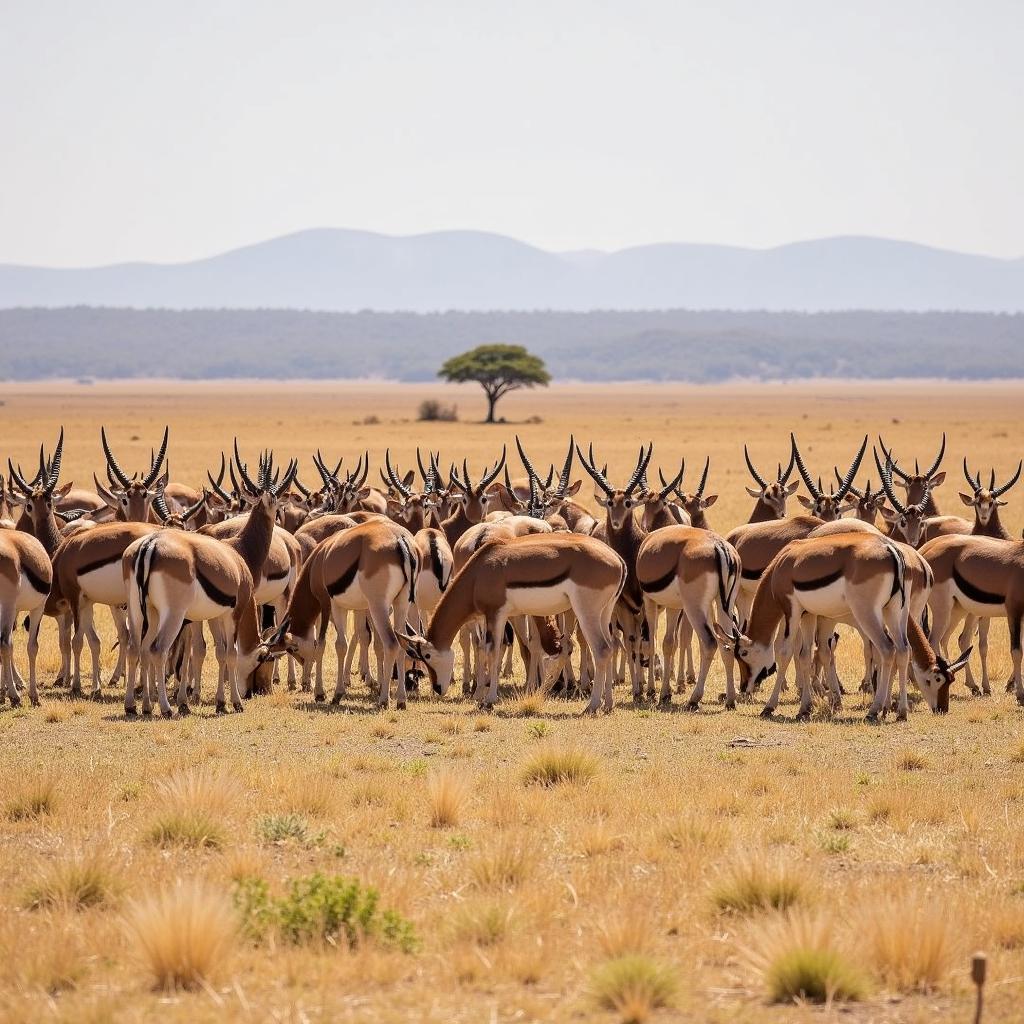The Enigmatic African Antelope: Springbok
The African Antelope Springbok, a symbol of grace and resilience, captivates with its unique adaptations and captivating behaviors. This article delves into the fascinating world of the springbok, exploring its physical characteristics, habitat, social dynamics, and its crucial role in the African ecosystem.
Unveiling the Springbok: Physical Attributes and Adaptations
Springbok are medium-sized antelopes, renowned for their distinctive markings and remarkable agility. Their sandy-brown coats, adorned with a white face and a dark brown stripe along their flanks, provide excellent camouflage in the arid landscapes they inhabit. Their slender build and long, thin legs are perfectly suited for speed and endurance, enabling them to outrun predators with ease. One of the most striking features of the springbok is its pronking behavior. When alarmed, these antelopes leap into the air with arched backs and stiff legs, a spectacular display that serves as a warning signal to other springbok.
The springbok’s adaptations extend beyond physical prowess. They have a highly efficient digestive system, allowing them to extract maximum nutrients from the sparse vegetation of their arid habitats. Their ability to conserve water and tolerate high temperatures further enhances their survival in challenging environments.
Habitat and Distribution: Where Do Springbok Roam?
The springbok’s preferred habitat is the dry grasslands and savannas of southern Africa. They are found in countries such as South Africa, Namibia, Botswana, and Angola, where they navigate the open plains with remarkable agility.  Springbok herd grazing in the African plains While they can tolerate harsh conditions, they are highly adaptable and can be found in a variety of habitats, from semi-deserts to coastal regions. Their distribution is influenced by factors such as rainfall patterns and the availability of food resources.
Springbok herd grazing in the African plains While they can tolerate harsh conditions, they are highly adaptable and can be found in a variety of habitats, from semi-deserts to coastal regions. Their distribution is influenced by factors such as rainfall patterns and the availability of food resources.
Social Dynamics: The Herd Mentality of Springbok
Springbok are highly social animals, often forming large herds that can number in the hundreds or even thousands. These herds provide protection from predators and enhance foraging efficiency. Within the herd, there is a complex social structure with dominant males leading smaller groups of females and their offspring. Young springbok, known as lambs, are born after a gestation period of around five months. They are incredibly precocious and can run within hours of birth, an essential adaptation for survival in a predator-rich environment.
The Springbok’s Role in the Ecosystem: A Vital Link
Springbok play a crucial role in the African ecosystem. As herbivores, they contribute to nutrient cycling and vegetation management. Their grazing activities help to maintain the balance of plant species and create habitats for other animals. They also serve as a vital food source for predators such as lions, cheetahs, and wild dogs. african deer springbok Their presence is an indicator of a healthy ecosystem, highlighting the interconnectedness of species within the African savanna.
Conservation Status: Protecting the Springbok
While springbok are currently not considered endangered, their populations face ongoing threats from habitat loss, hunting, and climate change. Conservation efforts, such as protected areas and sustainable hunting practices, are crucial for ensuring the long-term survival of this iconic African antelope. african animalsi mages with names Understanding the springbok’s ecological needs and implementing effective conservation strategies is essential for safeguarding this remarkable species for future generations.
Conclusion: The Enduring Legacy of the African Antelope Springbok
The African antelope springbok stands as a testament to the resilience and adaptability of life in the African savanna. Its unique physical characteristics, social behaviors, and ecological significance make it a captivating species worthy of admiration and protection. african antelope migration By continuing to study and conserve this iconic antelope, we can ensure that its enduring legacy continues to inspire and enrich the natural world.
FAQ
- What is the lifespan of a springbok? (A springbok can live up to 10 years in the wild.)
- What is the primary diet of a springbok? (Springbok are herbivores, primarily feeding on grasses, herbs, and shrubs.)
- How fast can a springbok run? (Springbok can reach speeds of up to 55 miles per hour.)
- What is the pronking behavior of a springbok? (Pronking is a series of vertical leaps performed by springbok, thought to be a warning signal to other springbok.)
- What are the main predators of springbok? (Lions, cheetahs, wild dogs, and leopards are among the main predators of springbok.)
- How do springbok adapt to arid environments? (Springbok have efficient digestive systems, can conserve water, and tolerate high temperatures.)
- What is the conservation status of the springbok? (Springbok are currently not considered endangered, but their populations are facing threats from habitat loss and hunting.) south african symbols
Other Questions and Related Articles
- Learn more about other African antelope species and their unique adaptations.
- Discover the impact of climate change on African wildlife populations.
- Explore the cultural significance of the springbok in southern African societies.
When you need assistance, please contact us by Phone: +255768904061, Email: kaka.mag@gmail.com or visit our address: Mbarali DC Mawindi, Kangaga, Tanzania. We have a 24/7 customer service team.



